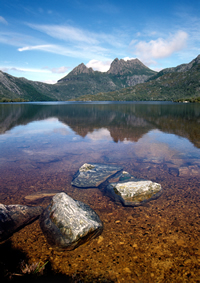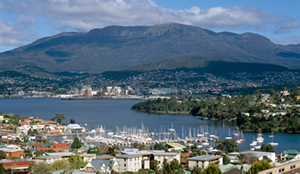Mapping Moves into the Digital Age in Tasmania
By Karen Richardson, Esri Writer
 Esri's Maplex software manages symbolization and annotation placement through user-defined rules based on map complexity. |
When tourists and locals pull on their hiking boots to trek through Tasmania's picturesque landscape, they often take a trusty companion along to guide them: a topographic map created by TASMAP, the Tasmanian government agency responsible for supplying accurate, up-to-date maps describing the mountain peaks, caves, and beaches of Australia's only island state. More than 40 percent of the state consists of national parks and reserve land with 1,000 mountain peaks, more than 300 islands, and some of the world's rarest animals, so there is much to keep a cartographer busy.
The 1:25,000-scale map series is the most popular of TASMAP's products and is used by government agencies, businesses, and consumers. This series provides large-scale basemaps for all of Tasmania and includes topographic information, such as elevation, water bodies, and government landmarks, along with property information. The series, produced since the 1970s, consists of 415 maps.
 The 1:25:000-scale map series consists of 415 large-scale basemaps for Tasmania including information like elevation, water bodies, government landmarks, and property information. |
Four decades of mapmaking means TASMAP has witnessed significant changes in map production methods-including the introduction of geographic information system (GIS) technology. "Before GIS, map production involved intricate manual processes, with a single map sheet taking many people months to produce," says Mark Chilcott, Spatial Operations, Geodata Services, Department of Primary Industry and Water. "Today, maps can be produced quickly and efficiently in about two weeks by automating many of the mundane tasks. This allows our cartographers to focus on cartography and reduces production time significantly."
Using Esri's ArcGIS suite of GIS software, TASMAP now manages, creates, and edits all necessary map layers digitally. The organization uses ArcInfo 9.3 for inputting and editing data, ArcGIS Server 9.3 Spatial Database Engine for managing the spatial data, and Feature Manipulation Engine (FME) Server from Esri business partner Safe Software Inc. to extract, transform, and load data. When maps are complete, they are sent via PDF file for offset printing, or are made available for download free or by credit card from TASMAP's online store.
GIS Lets Cartographers Focus on Cartography
When computerizing daily mapmaking activities, TASMAP focused on building on past experiences to create solutions that would help guide the agency toward the future. "It was important that we didn't reinvent the wheel," says Chilcott. "While the specifications for creating maps are the same, the methods are obviously quite different. Cartography is not a dead art; it is very much a required skill."
The heart of TASMAP's newfound efficiency is its ability to combine database-driven mapping with a geodatabase, a common data storage and management framework for ArcGIS. Since data is stored in one location, it can be updated and edited with little error. Using the geodatabase also means map attributes-such as north arrows, map name and number, grid references, and climate graphs-can be created using intelligent information directly from the data itself. TASMAP now stores these attributes with the map features themselves.
 ArcGIS is used for the entire mapping process, from data extraction to editing and finishing. |
All changes to these attributes are managed with an easy-to-use template that TASMAP created using ArcGIS to simplify editing and reduce the potential for mistakes. The template contains the map frame and all marginal information required for each sheet. For example, grid references are created from a sample point that is unique for each map and stored in the geodatabase. Staff members can edit data for new points and precalculate the Universal Grid Reference. Climate graphs are created directly from climate data obtained from the Australian government's Bureau of Meteorology (BOM). Map names, numbers, editions, and dates, as well as the cover and location box, are now objects generated from code. While the initial setup took some effort, the end result is that each map margin and template takes less than one minute to generate. Mistakes and errors are greatly reduced, and a considerable amount of work is eliminated. "Now our cartographers can focus on cartography," says Chilcott.
 ArcGIS ModelBuilder is used to create a weighted matrix to identify real-time stock levels of each map. |
Taming the marginal data meant TASMAP could focus on streamlining the extraction and geoprocessing of the map data itself. This task is now performed on each editor's desktop, using a personal geodatabase with ArcGIS and FME software. Using FME to build graphic geoprocessing models automates data manipulation from a variety of sources. Using GIS to create new information by applying geoprocessing operations to existing data (such as clip to boundary; making single layers into multiple layers; joining lookup tables; and rotating objects like waterfalls to rivers, gates to roads, and buildings to roads) saves TASMAP more time and effort. "ArcGIS and FME have many powerful tools," adds Chilcott. "The software is easy to adjust to meet our needs and, most importantly, the users can retain ownership of their data."
Digitally Managing Production with ArcGIS
Another area of improvement TASMAP found through automating cartographic production with ArcGIS was the placement of annotation on the map sheets. By digitally managing annotation, TASMAP has significantly reduced the time necessary to create each map. "Traditionally, lettering the map—the process of selecting the type, preparing the names, and placing them in position—was considered among the more complex and time-consuming parts of the cartographic process," says Chilcott. "While this is still one of the most time-consuming processes, it is now significantly less time consuming and considerably easier than in the past."
 Cradle Mountain is a popular hikers' paradise in Tasmania. |
Using Esri's Maplex extension to ArcGIS, annotation can now be created directly from the geodatabase. Maplex manages symbolization and annotation placement through user-defined rules based on map complexity. Annotation placement is prioritized according to sophisticated cartographic rules, and filters are set up to handle densely packed annotation in urban areas differently than filters for annotation in rural areas.
The last challenge that TASMAP faced in its cartographic production workflow was printing. TASMAP produces maps using offset printing, sending maps in PDF files to the printers. The maps are created using standard cyan, magenta, yellow, and key black (CMYK) color. "In the recent past, we would export the almost-completed map to Adobe Illustrator for finishing to ensure the CMYK color separation for offset printing could be achieved. Now we use ArcGIS for the entire mapping process-from data extraction, editing, finishing, and the final export to PDF for printing. No other application needs to be used in the entire process," Chilcott says.
Even with these efficiencies, producing 415 maps is a large task, requiring many resources. So TASMAP also uses GIS technology to more effectively manage the workflow of determining when to produce maps for use and resale. "The question is always, Which map sheet do I work on?" says Chilcott. ArcGIS is useful in answering this question. Using ArcGIS, TASMAP has developed tools to assist in managing map production. A feature class of the map extent is linked to the stock database to produce reports of real-time stock levels. ArcGIS ModelBuilder is used to create a weighted matrix to identify which maps should be worked on over the next 12 months. Stock levels for the coming year and the highest-selling areas are also predicted.
 ArcGIS helped TASMAP create maps with the same specifications and high-quality cartography in two weeks instead of six months and with fewer people. |
In the past, it took up to four cartographers six months to produce a map. Today, one cartographer takes two weeks to produce the same map to the same specifications with the same high-quality cartography. "Granted, in the past, the map production process also included the data capture process, which in itself was time consuming," says Chilcott. "With today's technology, the datasets come from our corporate and state spatial data infrastructure (SDI)." While the technology has changed, the results are the same: the maps remain high quality. The offset printing process is similar to how map production was originally done-but produced with significantly fewer resources and in much less time.
 Kangaroo Bay in Hobart, a city that hosts the finish of the annual Sydney to Hobart Yacht Race every winter. |
Technology, however, does not trump the art of cartography. "We have simply created tools to allow cartographers to focus on cartography," says Chilcott, who concluded with a quote from the preface to Elements of Cartography, Fifth Edition (Arthur Robinson, et al.): "Rapid changes in technology demand that practitioners learn not only ways of doing new things, but additional ways of doing old things with new equipment."
For more information, contact Chilcott at Mark.Chilcott@dpiw.tas.gov.au.